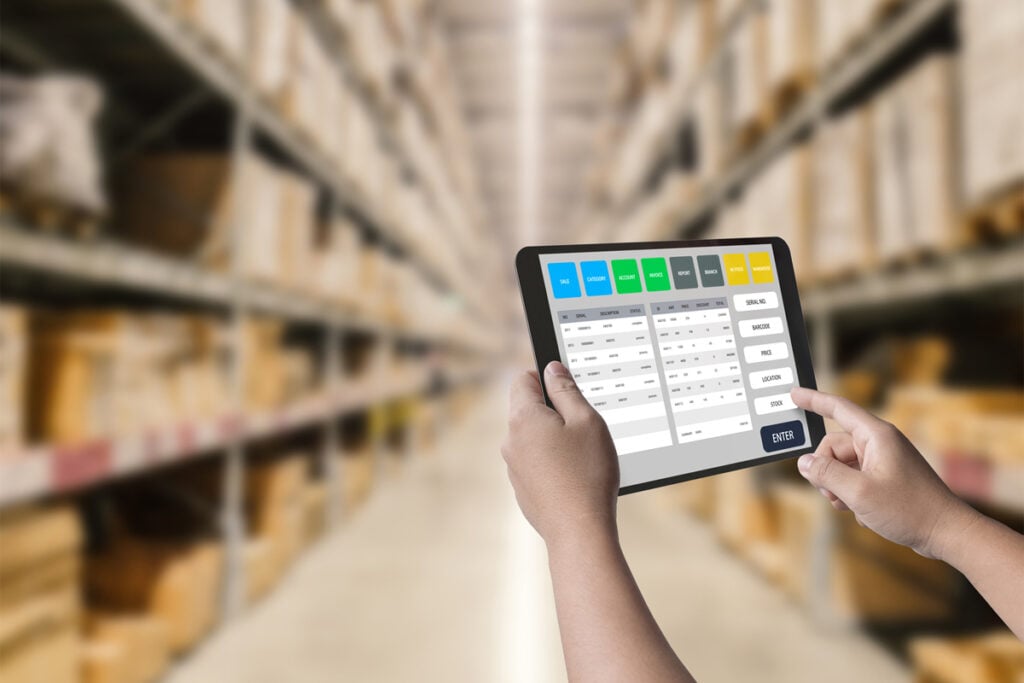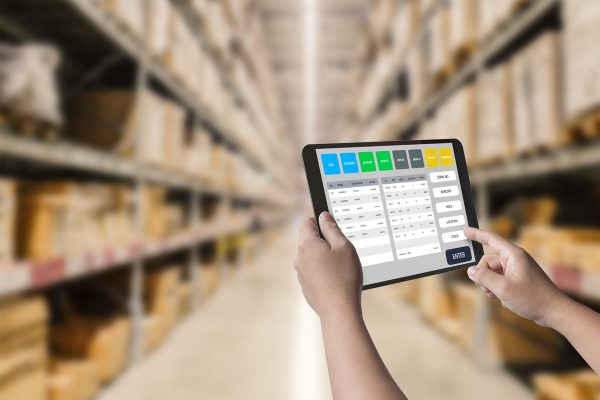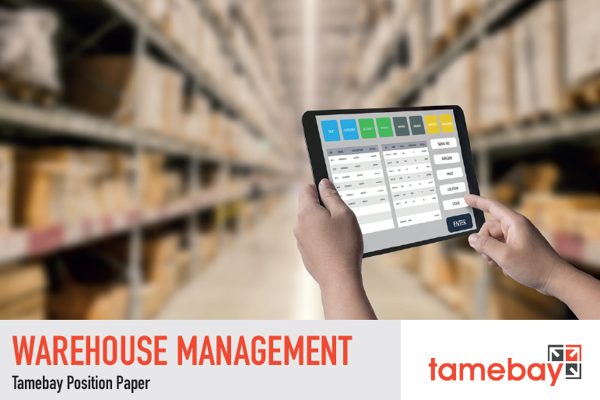Download or read online
This position paper on Warehouse Management is available as a free download to read offline at your convenience, or carry on reading below.
Warehouse Management
Every ecommerce business will have a warehouse, either your own warehouse where you despatch your goods from or possibly a warehouse belonging to a third party who store and ship your goods on your behalf – a fulfilment house.
Even if you use a fulfilment house, or perhaps a marketplace fulfilment service such as Amazon FBA, it’s likely that you’ll still have a warehouse and fulfil goods yourself. In this Position Paper we’ll examine how to run a warehouse efficiently and what options there are available to automate processes as your business grows.
We are going to start at the beginning with a small ecommerce start up and progress through to examining highly sophisticated warehouse operations with software solutions and even robots to assist with the picking and packing processes. Not every business will start at the basics, but the same lessons can be applied to both small and large businesses and whilst software solutions can result in invaluable time and money savings they can’t in themselves make your warehouse run efficiently.
What is Warehouse Management
Warehouse management is the process of organising everything in your warehouse and controlling how your operations run from goods in to sales shipments going out and not forgetting returns which will be arriving back and need processing.
You will want to make all processes run as smoothly as possible as the time average time taken to pick and pack an order carries a cost – both in time and salaries for either you or your staff. The more efficiently you can carry out the tasks required the more profitable you will be in the long run.
General Warehouse Layout
The first thing you should consider is how to lay out your warehouse and this will in part be determined by the type of goods you sell and the depth of inventory you carry. For some warehouses pallet racking is indicated whilst for others racking with smaller compartments or bins is more suited for the type of merchandise that will be stored. Often the product will dictate the storage, for instance if you sell shoes that come in boxes your needs will be every different to if you sell memory cards or USB sticks which are relatively small but probably arrive with hundreds or thousands in a single carton.
Warehouse zones
It is likely that you’ll want to segregate your warehouse into several areas such as: Goods In; Storage racking; packing area; packing supplies; shipping area; returns processing; and office space. In an ideal scenario you would have separate entrances for goods in and goods out so that products can flow through your warehouse but for many smaller warehouses this isn’t possible, so it makes practical sense to have a receiving area as well as a shipping area both close to the main warehouse doors.
Bulk storage
One common mistake in warehousing is to place all your inventory and packaging materials in the main storage area. If you order in large quantities, a bulk storage area for stock and supplies would be indicated where, although it might not be quite as easy to access stock, it can be stored more densely with smaller quantities being placed for easy access on a daily or weekly basis.
Typically, in warehouses with high racking, long term storage would be at the top of racks with stock replenished on lower shelves where pickers can access it without the need for a forklift truck. In smaller warehouse, bulk storage could simply be an area where cartons are stacked ready for shelves to be replenished as needed. This would hold true for packing supplies which can also be moved to the packing tables in daily or weekly quantities. Just because you have 5,000 jiffy bags in stock doesn’t mean you have to store 5,000 at the packing bench if you typically only use 500 per day.
Access to bulk storage need not be as unrestricted as your main storage area where pickers will need easy access to gather products as they are sold and ready to ship.
Warehouse Locations
Warehouse locations are simply a record of where stock is located. Smaller retailers, particularly sole traders, often commit warehouse locations to memory and there’s nothing wrong with this at that level. However as soon as you have employees you’ll need a more robust way to locate stock. This is especially true if you have warehousing in multiple locations.
Typically, you’ll store stock based on Warehouse name (if you have multiple warehouses), Racking row, Shelf number and Bin location. Larger warehouse may also have named zones to ease navigation. As an example, a product could be in Warehouse Rotherham, Zone 2, Row B1, Shelf 2, Bin 1. Smaller warehouses in single locations will have a simple system such as Row B1, Shelf 2, Bin 1. As your operations grow and your warehouse needs become larger the complexity of your naming will grow.
Arranging Inventory
It is no surprise that retailers automatically locate their fastest moving lines closest to the packing table. The quicker goods can be retrieved and packed the more efficiently the warehouse will run.
There is a trade-off however, if goods are particularly bulky having them located in areas where handling is easier will be indicated. For instance, if they are pre-boxed ready to ship and only need the addition of a shipping label then placing them on racking close to your goods out bay makes a lot more sense.
It is also worth considering how easy it is to pick goods with minimal errors. If you sell goods which are very similar, for instance t-shirts in multiple sizes, you can reduce picking errors by storing different sizes in the same colour in different warehouse locations. It’s much easier for your pickers to distinguish between a medium red and a medium black t-shirt than it is to distinguish between a medium red and a large red. Even if your stock is barcoded and your warehouse pickers and packers use hand held scanners to confirm the correct item has been picked, making it visually easy to locate the correct product will still speed up the process.
You should also consider which products are regularly sold together or those that you sell as bundles – having the components to make up a single bundled product in the same warehouse area will ultimately save hours if not days of picking time over the course of a year.
Managing Stock
You should be aware of when stock is due to arrive and planning for this should be a priority. Every warehouse is under pressure to ship the orders sold that day to the customers waiting for their purchases, but stock that arrives should be processed, stored and made available for sale in the shortest possible time.
This also holds true for returns and a separate receiving and processing area for returns is normally indicated. You’ll want to assess the stock to determine if it is resaleable or can be refurbished to new and place back into sale stock as well as processing refunds for customers.
Logistics
Part of your warehouse optimisation will be to ensure the smooth flow of stock from the shelves to the courier. You’ll need to pick and pack orders, produce shipping labels and despatch orders with a range of couriers.
Fulfilling Orders
When the orders are flooding in there are several strategies that can be put in place to manage the workload. These may be determined by the urgency of the order (same day or next day deliveries take priority over economy), by the order in which your carrier arrive (does Royal Mail pick up later or earlier than your couriers), or by the ease of product handling (prepacked product that only needs a shipping label can be handled differently to fragile products that require specialist packing).
There are also several different ways that you can pick orders:
- Single Order
Stock to complete one order at a time is picked - Batch Picking
Ideal if you have multiple orders for the same product as they can all be picked together - Zone Picking
A warehouse worker is assigned all the products from one warehouse zone to pick with other workers assigned picking lists for different zones - Wave Picking
Orders are assigned in waves and products consolidated into single orders at the packing table. When a pick list is complete the next wave of orders will be assigned.
There will be a right and a wrong method for you and your warehouse and they may vary according to time of day. For instance, you may implement batch picking but close to your courier pick up time switch to wave picking to get orders with a next day promise out on time.
Packing
When it comes to packing there are a plethora of packaging materials on offer, many of which were discussed in our Packaging Position Paper. The balance is to cut down on the number of box or mailing bag sizes you hold to the minimum but not so much that you’re using excessive amounts of void fill.
Packaging material should be topped up at regular intervals which will vary from daily or weekly to hourly dependant on the size of your operations, how many parcels you are shipping and the available space in your packing area.
Shipping
Producing invoices and labels is normally the first warehouse tasks for a smaller business to implement. Often a new home-grown business will start hand writing labels or cutting and pasting addresses from their website or marketplace orders into their shipping solution.
There are several solutions available on the market varying in complexity to those which will produce integrated labels to solutions which will import your orders from multiple marketplaces, produce invoices and shipping labels as well as multichannel solutions which will also manage your stock and marketplace listings.
You will as you grow start to use multiple carriers and a robust solution should be able to automatically determine the optimal carrier to used based on product type and value, weight, shipping speed selected by the customer and potentially even time of day based on your courier collection times.
Warehouse Management Systems
As you grow you may decide to consider a full-blown Warehouse Management System (WMS) to replace or sit alongside your existing software solutions. The software is designed to support you existing operations and staff, automate processes such as the production of picking lists and can even be smart enough to optimise picking lists according to where stock in your warehouse is located, guiding your staff on the optimal route to collect all the items required to fulfil the orders being worked on.
It should be emphasised that WMS solutions may be standalone, or some functionality could be built into a large multichannel solution. However, a WMS isn’t a replacement for multichannel solutions and should be specified and considered separately, although of course you’ll want a robust integration between the two solutions.
One of the biggest advantages of a robust WMS solution is the elimination of picking and packing errors that comes with automation. You could integrate a WMS and leave your processes as manual, but with barcoded stock your warehouse staff can start to scan each individual product to confirm the correct one is picked and then scan both the product and invoice at the packing table to again confirm that the correct product is being sent to the correct customer.
One of the biggest benefits of a WMS is that it frees you to place incoming stock on any rack, shelf or bin that’s available in your warehouse. When the stock is placed on the shelf the bin is scanned and your WMS will remember the location of the item, when it’s time to pick that product the WMS will recall where it was stored. This means that all available space can be utilised to full effect and removes the need to store all of one product on the same shelf every time – even if you only have a few of one product left in stock and the rest of the shelf is empty. When replenishments arrive, they can be situated anywhere in the warehouse that has available space.
Robots
Only the very largest warehouses will be fully or semi-automated with the use of robots, but there are several different tasks that they can complete. Some will be very sophisticated such as those in Amazon warehouses who pick up racks of product and transport them to packing tables so that human never have to use pick lists and manually gather stock. Others will be semi-automated packing devices or label production where the label is automatically applied to the outgoing parcel.
It is important to note that warehouses heavily reliant on robots are some of the most sophisticated in the world and they are truly dependant on robust warehouse management principles. Yes, they will have a WMS running in the background controlling the robots, but the use of robots is only possible by following the warehouse management techniques described in this paper.
You may not have robots in your warehouse but following robust warehouse management principles are essential for the busiest warehouses and applying these principles to even the smallest of warehouses will ensure operations flow smoothly.







One Response
Your article came just at the time I needed it most. I believe with the knowledge I’ve gotten from this article, I’ll be able to accelerate my business.